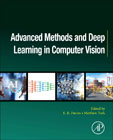
Advanced Methods and Deep Learning in Computer Vision presents advanced computer vision methods, emphasizing machine and deep learning techniques that have emerged during the past 5-10 years. The book provides clear explanations of principles and algorithms supported with applications. Topics covered include machine learning, deep learning networks, generative adversarial networks, deep reinforcement learning, self-supervised learning, extraction of robust features, object detection, semantic segmentation, linguistic descriptions of images, visual search, visual tracking, 3D shape retrieval, image inpainting, novelty and anomaly detection. This book provides easy learning for researchers and practitioners of advanced computer vision methods, but it is also suitable as a textbook for a second course on computer vision and deep learning for advanced undergraduates and graduate students. Provides an important reference on deep learning and advanced computer methods that was created by leaders in the field Illustrates principles with modern, real-world applications Suitable for self-learning or as a text for graduate courses INDICE: List of contributors xi About the editors xiii Preface xv 1. The dramatically changing face of computer vision E.R. DAVIES 1.1 Introduction - computer vision and its origins 1 1.2 Part A - Understanding low-level image processing operators 4 1.3 Part B - 2-D object location and recognition 15 1.4 Part C - 3-D object location and the importance of invariance 29 1.5 Part D - Tracking moving objects 55 1.6 Part E - Texture analysis 61 1.7 Part F - From artificial neural networks to deep learning methods 68 1.8 Part G - Summary 86 References 87 2. Advanced methods for robust object detection ZHAOWEI CAI AND NUNO VASCONCELOS 2.1 Introduction 93 2.2 Preliminaries 95 2.3 R-CNN 96 2.4 SPP-Net 97 2.5 Fast R-CNN 98 2.6 Faster R-CNN 101 2.7 Cascade R-CNN 103 2.8 Multiscale feature representation 106 2.9 YOLO 110 2.10 SSD 112 2.11 RetinaNet 113 2.12 Detection performances 115 2.13 Conclusion 115 References 116 3. Learning with limited supervision SUJOY PAUL AND AMIT K. ROY-CHOWDHURY 3.1 Introduction 119 3.2 Context-aware active learning 120 3.3 Weakly supervised event localization 129 3.4 Domain adaptation of semantic segmentation using weak labels 137 3.5 Weakly-supervised reinforcement learning for dynamical tasks 144 3.6 Conclusions 151 References 153 4. Efficient methods for deep learning HAN CAI, JI LIN, AND SONG HAN 4.1 Model compression 159 4.2 Efficient neural network architectures 170 4.3 Conclusion 185 References 185 5. Deep conditional image generation GANG HUA AND DONGDONG CHEN 5.1 Introduction 191 5.2 Visual pattern learning: a brief review 194 5.3 Classical generative models 195 5.4 Deep generative models 197 5.5 Deep conditional image generation 200 5.6 Disentanglement for controllable synthesis 201 5.7 Conclusion and discussions 216 References 216 6. Deep face recognition using full and partial face images HASSAN UGAIL 6.1 Introduction 221 6.2 Components of deep face recognition 227 6.3 Face recognition using full face images 231 6.4 Deep face recognition using partial face data 233 6.5 Specific model training for full and partial faces 237 6.6 Discussion and conclusions 239 References 240 7. Unsupervised domain adaptation using shallow and deep representations YOGESH BALAJI, HIEN NGUYEN, AND RAMA CHELLAPPA 7.1 Introduction 243 7.2 Unsupervised domain adaptation using manifolds 244 7.3 Unsupervised domain adaptation using dictionaries 247 7.4 Unsupervised domain adaptation using deep networks 258 7.5 Summary 270 References 270 8. Domain adaptation and continual learning in semantic segmentation UMBERTO MICHIELI, MARCO TOLDO, AND PIETRO ZANUTTIGH 8.1 Introduction 275 8.2 Unsupervised domain adaptation 277 8.3 Continual learning 291 8.4 Conclusion 298 References 299 9. Visual tracking MICHAEL FELSBERG 9.1 Introduction 305 9.2 Template-based methods 308 9.3 Online-learning-based methods 314 9.4 Deep learning-based methods 323 9.5 The transition from tracking to segmentation 327 9.6 Conclusions 331 References 332 10. Long-term deep object tracking EFSTRATIOS GAVVES AND DEEPAK GUPTA 10.1 Introduction 337 10.2 Short-term visual object tracking 341 10.3 Long-term visual object tracking 345 10.4 Discussion 367 References 368 11. Learning for action-based scene understanding CORNELIA FERMÜLLER AND MICHAEL MAYNORD 11.1 Introduction 373 11.2 Affordances of objects 375 11.3 Functional parsing of manipulation actions 383 11.4 Functional scene understanding through deep learning with language and vision 390 11.5 Future directions 397 11.6 Conclusions 399 References 399 12. Self-supervised temporal event segmentation inspired by cognitive theories RAMY MOUNIR, SATHYANARAYANAN AAKUR, AND SUDEEP SARKAR 12.1 Introduction 406 12.2 The event segmentation theory from cognitive science 408 12.3 Version 1: single-pass temporal segmentation using prediction 410 12.4 Version 2: segmentation using attention-based event models 421 12.5 Version 3: spatio-temporal localization using prediction loss map 428 12.6 Other event segmentation approaches in computer vision 440 12.7 Conclusions 443 References 444 13. Probabilistic anomaly detection methods using learned models from time-series data for multimedia self-aware systems CARLO REGAZZONI, ALI KRAYANI, GIULIA SLAVIC, AND LUCIO MARCENARO 13.1 Introduction 450 13.2 Base concepts and state of the art 451 13.3 Framework for computing anomaly in self-aware systems 458 13.4 Case study results: anomaly detection on multisensory data from a self-aware vehicle 467 13.5 Conclusions 476 References 477 14. Deep plug-and-play and deep unfolding methods for image restoration KAI ZHANG AND RADU TIMOFTE 14.1 Introduction 481 14.2 Half quadratic splitting (HQS) algorithm 484 14.3 Deep plug-and-play image restoration 485 14.4 Deep unfolding image restoration 492 14.5 Experiments 495 14.6 Discussion and conclusions 504 References 505 15. Visual adversarial attacks and defenses CHANGJAE OH, ALESSIO XOMPERO, AND ANDREA CAVALLARO 15.1 Introduction 511 15.2 Problem definition 512 15.3 Properties of an adversarial attack 514 15.4 Types of perturbations 515 15.5 Attack scenarios 515 15.6 Image processing 522 15.7 Image classification 523 15.8 Semantic segmentation and object detection 529 15.9 Object tracking 529 15.10 Video classification 531 15.11 Defenses against adversarial attacks 533 15.12 Conclusions 537 References 538 Index 545
- ISBN: 978-0-12-822109-9
- Editorial: Academic Press
- Encuadernacion: Rústica
- Páginas: 582
- Fecha Publicación: 12/11/2021
- Nº Volúmenes: 1
- Idioma: Inglés
